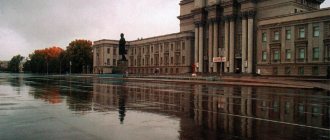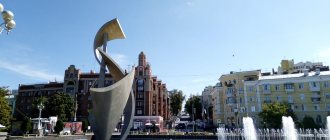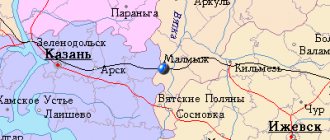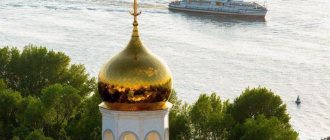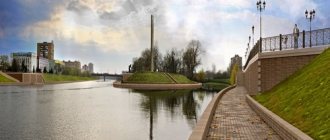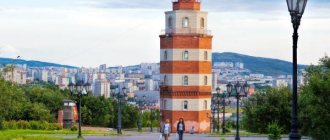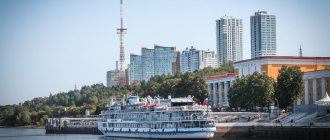Photo of Samara from above - a space city on the Volga
© img.geliophoto.com
Samara is the ninth largest city in Russia by population. The city sets records for a number of indicators: it has the highest train station, the longest embankment on the Volga and the largest city square in Europe.
Since Soviet times, Samara has remained the largest cruise and tourist hub in the Middle Volga, as well as the center of the country's aviation and space industries. From 1968 to 2013, all modifications of Tu-154 aircraft were produced here, and the production of Soyuz launch vehicles, on which all Russian cosmonauts take flight, continues successfully to this day.
1. Samara is located opposite the largest bend in the middle reaches of the Volga at the place where the left tributary called Samara flows into it.
© img.geliophoto.com
2. Samara was founded in 1586, when Prince Grigory Zasekin, on the instructions of Tsar Fyodor I Ioannovich, built a defensive fortress on the banks of the Samara River to protect shipping on the Volga. Between 1935 and 1991, Samara was called Kuibyshev - after the name of Valerian Kuibyshev, a Russian revolutionary, Soviet party leader and Stalin's closest associate on economic issues. And during the Second World War, the city became the reserve capital of the USSR in case of the capture of Moscow.
© img.geliophoto.com
3. Since 1967, Samara has been a city with a population of one million. Today the city is inhabited by 1.157 million people. Together with its surroundings, the Samara agglomeration ranks 11th among the most densely populated in the country - 2.7 million people.
© img.geliophoto.com
4. Kuibyshev Square is the largest in Europe. Together with adjacent parks, it occupies more than 17 hectares.
© img.geliophoto.com
5. The Samara Academic Opera and Ballet Theater is located in a massive building erected in the neoclassical style in 1931-1932.
© img.geliophoto.com
6. During the war, the ballet and opera troupe of the Bolshoi Theater moved to Kuibyshev from Moscow. This became a powerful impetus for the development of the repertoire of the Samara Theater.
© img.geliophoto.com
7. Kuibyshev, as a city with a population of one million, received funding in the late Soviet era for the construction of an off-street rail transport system. The Samara metro today consists of ten stations on one line with a length of 11.6 km. About 36 thousand passengers use the subway every day.
© img.geliophoto.com
8. Chapaev Square is six times smaller than Kuibyshev Square, but it also houses the Samara Drama Theatre, one of the oldest in Russia. The ensemble of the square is completed by a monument to the Chapaevites, erected in 1932. There is a copy of this monument in St. Petersburg.
© img.geliophoto.com
9. Samara Academic Drama Theater named after. Gorky is located in a pseudo-Russian style building built in 1888. For its expressive architecture, the townspeople nicknamed the theater building the “gingerbread house.”
© img.geliophoto.com
10. Bell tower of the Iversky Samara Women's Monastery.
© img.geliophoto.com
11. In Samara, proclaimed the reserve capital of the USSR in case of the capture of Moscow, a bunker was built for Stalin at a depth of 37 meters. True, the leader of the peoples himself never appeared here.
© img.geliophoto.com
12. The Church of the Sacred Heart of Jesus was built in 1906 in the neo-Gothic style with donations from the Catholic community of Samara.
© img.geliophoto.com
13. The altar of the church is decorated with a fresco copying the painting “Christ of St. John of the Cross” by Salvador Dali.
© img.geliophoto.com
14. One of the urban legends says that there is a network of tunnels under Samara. You can use them to get out on the other side of the Volga and on the islands.
© img.geliophoto.com
15. Samara State Philharmonic. The new building was built in 1974 and is stylized as Samara Art Nouveau.
© img.geliophoto.com
16. Evangelical Lutheran Community of St. George. An architectural ensemble built in 1865 in the provincial neo-Gothic style, dating back to the German Middle Ages.
© img.geliophoto.com
17. Kuibysheva street. It was from here that the first trolleybus route in Samara was launched in 1942.
© img.geliophoto.com
18. Over the years, Kuibyshev Street was called Main, Cossack, Torgovaya, Dvoryanskaya, Kerenskaya, Sovetskaya.
© img.geliophoto.com
19. Revolution square. Initially, in the center of the square there was a monument to Alexander II, which was dismantled after the revolution, leaving the pedestal. A monument to Lenin was erected on it in 1927, which still stands here.
© img.geliophoto.com
20. Samara Regional Art Museum named after. Annette Bass is one of the country's largest collections of painting, iconography, as well as Russian avant-garde and Soviet art.
© img.geliophoto.com
21. The building in the neoclassical style was built in 1915 as a result of a total reconstruction and addition of a merchant house from 1880.
© img.geliophoto.com
22. Samara is the cruise center of the Volga region. In terms of the number of motor ships being formed, the city is second only to Moscow and St. Petersburg. Every year, during the navigation period, at least 15 different ships take on board cruise passengers from Samara.
© img.geliophoto.com
23. During the navigation period, from the Samara river station you can take a cruise ship to Moscow and Astrakhan. The annual cruise tourist flow in Samara is at least 45 thousand passengers.
© img.geliophoto.com
24. The Samara fountain on the Volga embankment is one of the symbols of the city, which appeared in honor of its 400th anniversary.
© img.geliophoto.com
25. “Samarsky Arbat” is a pedestrian zone of Leningradskaya Street.
© img.geliophoto.com
26. The pedestrian section of the street appeared in 2011, nine years after the city authorities decided to liquidate the clothing market on this site.
© img.geliophoto.com
27. People call the street Leningradka.
© img.geliophoto.com
28. Samara railway station is the tallest station building in Europe.
© img.geliophoto.com
29. The height of the building with its spire is 101 meters, which is comparable to the height of a 32-story building.
© img.geliophoto.com
30. The station has 8 platforms and 15 tracks.
© img.geliophoto.com
31. The Frunzensky Bridge over the Samara River was opened in 2021.
© img.geliophoto.com
32. Glory Square and the Samara Region Administration building. Construction of the square began in 1965 and was completed in three years.
© img.geliophoto.com
33. Monument of Glory. A 13-meter figure of a worker with wings in his hands on a 40-meter pedestal.
© img.geliophoto.com
34. The monument is considered one of the most recognizable symbols of Samara. Placed as a token of gratitude to the workers of the aviation industry, whose labor feat made an invaluable contribution to the victory in the Second World War.
© img.geliophoto.com
35. Along with the official one, the monument also received popular names, for example, “Panikovsky with a goose” in honor of the character in the work “The Golden Calf”, and “Wings”. Sometimes the monument is mistaken for a monument to Gagarin.
© img.geliophoto.com
36. Descent of Glory Square.
© img.geliophoto.com
37. Church of the Great Martyr George the Victorious. A small church in the Russian-Byzantine style was built in honor of the 1000th anniversary of the baptism of Rus' and the 55th anniversary of the victory in the Second World War.
© img.geliophoto.com
38. Panorama of Samara Square.
© img.geliophoto.com
39. The Ladya Stella adorns the Oktyabrskaya Embankment of Samara and personifies the history of the region, which welcomed merchants and knights from all over the country.
© img.geliophoto.com
40. The stele was installed in 1986 in honor of the 400th anniversary of the founding of Samara.
© img.geliophoto.com
41. The headquarters of OJSC Samaraneftegaz, a Russian oil producing company that is part of the OJSC NK Rosneft group.
© img.geliophoto.com
42. Monument to the Soyuz launch vehicle at the museum and exhibition. Samara made a significant contribution to space exploration and the creation of a nuclear missile shield. The NK-33 rocket engine was designed and is still being produced at the Kuznetsov association in Samara. Nine modifications of launch vehicles and 27 types of spacecraft were produced. Today, every third launch into space is carried out on Samara-made launch vehicles.
© img.geliophoto.com
43. The facade of the museum building is decorated with an authentic Soyuz - this is the only assembled vertically mounted launch vehicle in Europe. The height of the rocket together with the building is 68 m, weight is 20 tons.
© img.geliophoto.com
44. The installed copy of the rocket was manufactured in 1984 by Kuibyshev as a model for training combat crews at the Plesetsk cosmodrome. In 1999, the rocket, which had already exhausted its service life, was presented to the TsSKB-Progress RKTs in honor of the 40th anniversary of the enterprise, which converted it into a mock-up.
© img.geliophoto.com
45.
© img.geliophoto.com
46. Cathedral of Cyril and Methodius on Barboshina Polyana.
© img.geliophoto.com
47. The temple building was erected in the neoclassical style. The height of the cathedral together with the cross is 57 meters, and the bell tower is 73 meters.
© img.geliophoto.com
48. The Samara Arena stadium was built specifically for the 2021 FIFA World Cup.
© img.geliophoto.com
49. The stadium with a capacity of almost 45 thousand spectators hosted six matches during the World Cup.
© img.geliophoto.com
50. The occupancy rate of matches held as part of the World Cup ranged from 95 to 100%.
© img.geliophoto.com
51. Administrative and dispatch building "Gazprom Transgaz Samara".
© img.geliophoto.com
52. Monument to the Il-2 aircraft in the park at the intersection of Moskovsky Avenue and Kirov Avenue.
© img.geliophoto.com
53. “Cool Keys” is a microdistrict consisting of more than 300 residential buildings for 100 thousand people.
© img.geliophoto.com
54. Officially, the microdistrict is called “Cool Keys,” but residents call it exclusively by the name of its creator, businessman Vladimir Koshelev.
© img.geliophoto.com
55. Pixel mural, stylized as 8-bit graphics on a football theme, on residential buildings in the Privolzhsky microdistrict.
© img.geliophoto.com
56. An-2, An-12, Mi-8, Yak-42, Tu-104, Tu-144, Tu-154 airplanes and helicopters are based at the airfield of the Samara State Aerospace University in Smyshlyaevka. Students studying the operation of aircraft equipment undergo practical training there.
© img.geliophoto.com
57. Tu-144 USSR-77108. Participated in state tests. During the testing process, he performed 50 flights with a total flight time of 68 hours, of which 6 hours were supersonic. Carried mail. On August 27, 1987, he flew to the airfield of the Kuibyshev Aviation Institute.
© img.geliophoto.com
58. Samara is the largest aviation center in the country, which began to actively develop in 1941 after the evacuation of thirty enterprises of the People's Commissariat of the Aviation Industry of the USSR to Kuibyshev. From 1970 to 1998, the Kuibyshev Aviation Plant, and later from 1998 to 2013, at the Samara enterprise Aviakor produced the most popular Soviet passenger airliner, the Tu-154. The legendary Il-2 attack aircraft, nicknamed the flying tank, was also produced in Kuibyshev.
© img.geliophoto.com
59. Building-iron, office.
© img.geliophoto.com
60. Samara Choral Synagogue. It was built in 1908 in pseudo-Moorish style. Already in 1929, the synagogue was closed and during the Soviet years the building housed first the Palace of Culture, and later a bread factory. There are currently plans to reconstruct and restore the synagogue.
© img.geliophoto.com
61. Swimming pool of CSKA Air Force.
© img.geliophoto.com
62. House of Industry. Built in 1936 with stones left over from the destroyed Cathedral. It is a monument of constructivism, although during the reconstruction carried out in 1961, the constructivist appearance of the building was partially lost and became more consistent with the spirit of socialist realism. It is now an office building.
© img.geliophoto.com
63. Strukovsky Garden is the oldest park in Samara, located on the banks of the Volga, next to the Samara Drama Theater.
© img.geliophoto.com
64.
© img.geliophoto.com
65. Zhigulevsky brewery is one of the oldest breweries in Russia. It was built in 1881 by an Austrian citizen Alfred Filippovich von Vacano. All buildings located on the territory of the brewery are objects of cultural heritage of federal significance. Today the plant produces 700 million liters of beer per year.
© img.geliophoto.com
66. The building of Samaraneftegaz OJSC is a Russian oil producing company, part of the Rosneft Oil Company OJSC group.
© img.geliophoto.com
67. Bell tower of the Iversky Samara Women's Monastery.
© img.geliophoto.com
68. Volga.
© img.geliophoto.com
